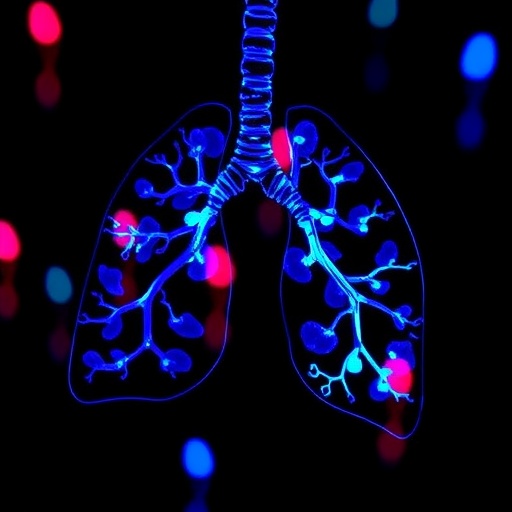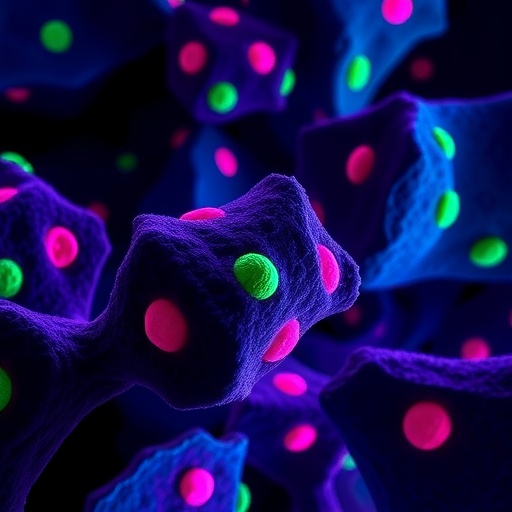In the relentless battle against lung adenocarcinoma—one of the deadliest and most prevalent forms of lung cancer—a new beacon of hope has emerged from recent scientific investigations. Researchers have identified an epigenetic regulator, KAT2A, as a critical player influencing not only the proliferation of lung adenocarcinoma cells but also their capacity to evade the immune system, potentially paving the way for groundbreaking diagnostics and targeted therapies.
Lung adenocarcinoma (LUAD) remains a formidable clinical challenge, characterized by aggressive progression, multifaceted molecular alterations, and a dismal overall survival rate. Despite advances in treatment, the complex interplay between tumor growth and immune escape mechanisms has hindered the development of universally effective interventions. In this context, the novel insights into KAT2A’s role illuminate new dimensions of tumor biology that may transform prognostic assessments and therapeutic strategies.
KAT2A, known scientifically as lysine acetyltransferase 2A, has been previously implicated in oncogenic pathways across various cancers, yet its precise function in LUAD has remained inadequately understood. Through a comprehensive series of bioinformatics analyses integrating The Cancer Genome Atlas (TCGA) and multiple Gene Expression Omnibus (GEO) datasets, researchers confirmed that KAT2A expression is markedly elevated in LUAD tissues. The elevated expression distinguished tumor samples from normal lung tissue, suggesting KAT2A’s involvement in the tumor microenvironment.
Importantly, statistical analyses revealed significant correlations between KAT2A expression and key clinicopathological parameters including TNM stage, pathological stage, patient sex, and tumor localization. Such associations underscore its potential utility not merely as a biomarker but as a reflection of underlying tumor biology that affects disease progression.
Survival analysis highlighted that patients exhibiting high KAT2A expression suffered significantly reduced overall survival rates across diverse clinical subgroups. This prognostic implication was reinforced through multivariate regression models which identified KAT2A as an independent prognostic factor. Integration of these findings into a nomogram model showcased how KAT2A levels could enhance precision in clinical decision-making, offering clinicians a quantified risk assessment tool.
Delving deeper into the molecular mechanisms influenced by KAT2A, functional enrichment analyses revealed that its associated genes are heavily involved in crucial biological processes and signaling pathways known to govern cell cycle regulation, DNA repair, and immune response modulation. Specifically, Gene Ontology (GO) and KEGG pathway analyses pointed towards pathways that facilitate tumor cell survival and immune evasion, marking KAT2A as a central orchestrator of these oncogenic processes.
Beyond genomic correlations, KAT2A’s interaction with the tumor immune microenvironment constituted a pivotal finding. Using sophisticated bioinformatics techniques alongside publicly available immunogenomic databases, the study demonstrated that KAT2A expression modulates immune cell infiltration patterns. Altered profiles of tumor-infiltrating lymphocytes, myeloid-derived suppressor cells, and macrophages were linked with KAT2A levels, suggesting that KAT2A shapes an immunosuppressive milieu favorable to tumor escape.
To validate these computational insights, the researchers conducted a battery of functional experiments both in vitro and in vivo. Knockdown of KAT2A in LUAD cell lines led to pronounced reductions in cell proliferation, colony formation, and survival. Flow cytometric analysis revealed increased apoptotic activity upon KAT2A suppression, confirming its role in promoting tumor cell viability.
In animal xenograft models, tumors derived from KAT2A-depleted cells exhibited significantly impaired growth dynamics when compared with control groups. This dramatic attenuation of tumor progression in vivo corroborates the oncogenic dependency of LUAD on KAT2A activity.
Moreover, mechanistic exploration revealed that KAT2A influences immune evasion by regulating the expression of checkpoint molecules and cytokines involved in dampening anti-tumor immune responses. Such modulation highlights the potential for therapeutic interventions targeting KAT2A to not only suppress tumor growth but also to restore immune surveillance mechanisms.
Collectively, this robust body of evidence establishes KAT2A as a multifaceted oncogenic driver in lung adenocarcinoma, with compelling ramifications for prognosis and therapy. The capacity of KAT2A to integrate signals governing cell proliferation and immune escape situates it as a promising candidate for the development of novel diagnostic biomarkers and targeted treatments.
The discovery arrives at a crucial juncture when personalized medicine and immuno-oncology are reshaping the landscape of cancer care. By harnessing the prognostic and therapeutic potential of KAT2A, there may be an opportunity to transform outcomes for patients grappling with LUAD’s aggressive nature.
Future research is anticipated to expand on these findings by elucidating the detailed molecular interactome of KAT2A and conducting clinical trials to assess the efficacy and safety of KAT2A-targeted therapies. Additionally, exploring combinatorial approaches that include immune checkpoint inhibitors could amplify anti-cancer effects, offering hope for long-term remission.
In conclusion, this comprehensive investigation into KAT2A underscores a paradigm shift in understanding lung adenocarcinoma’s pathogenesis. It highlights the essential role of epigenetic regulation in cancer biology and opens avenues ushering in precision oncology strategies that marry molecular targeting with immune modulation. The scientific community eagerly awaits the translation of these promising discoveries from bench to bedside.
Subject of Research: The role of KAT2A in lung adenocarcinoma, focusing on its influence on tumor proliferation and immune escape mechanisms.
Article Title: KAT2A: a prognostic biomarker influencing proliferation and immune escape in lung adenocarcinoma
Article References:
Ke, Z., Xu, H., Shen, K. et al. KAT2A: a prognostic biomarker influencing proliferation and immune escape in lung adenocarcinoma. BMC Cancer 25, 1753 (2025). https://doi.org/10.1186/s12885-025-15031-w
Image Credits: Scienmag.com
DOI: 10.1186/s12885-025-15031-w (Published 12 November 2025)
Tags: bioinformatics in cancer researchCancer Genome Atlas insightsepigenetic regulators in cancerGene Expression Omnibus studiesimmune evasion in tumorsKAT2A expression in tumor tissuesKAT2A lung cancer biomarkerlung adenocarcinoma researchoncogenic pathways in lung cancerprognostic biomarkers in oncologytargeted therapies for LUADtumor progression mechanisms





